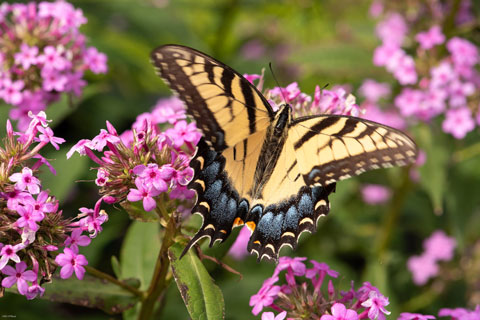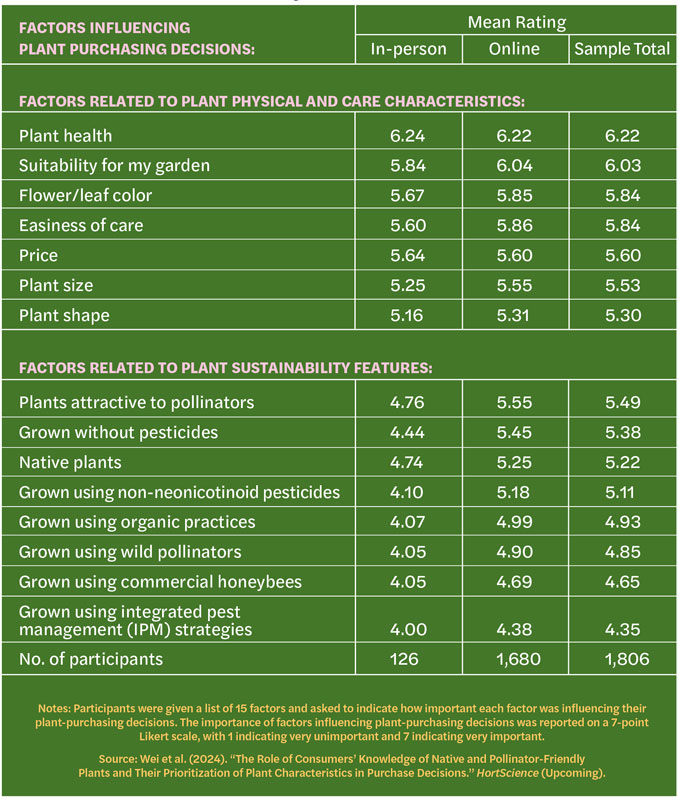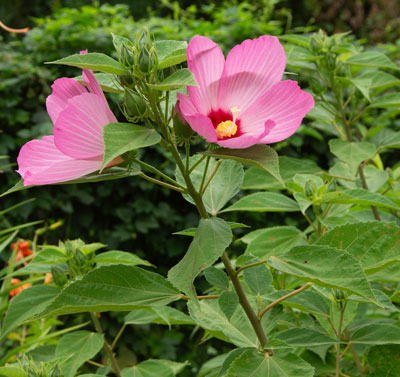8/1/2024
The More You Know
Xuan Wei, Melinda Knuth & Hayk Khachatryan

As urbanization continues to expand, the importance of sustainable landscaping becomes increasingly critical. This shift has sparked a growing interest in planting native and pollinator-friendly plants in residential gardens and landscapes. Incorporating native and pollinator-friendly plants has the potential to enhance local biodiversity, support ecosystem services and provide habitats for pollinators. These attributes are essential for maintaining sustainable food production. Despite the potential benefits these environmentally friendly landscapes (EFLs) can provide, the success of integrating native and pollinator-friendly plants heavily depends on consumer awareness and their purchasing decisions.
Pictured: Eastern Tiger Swallowtail on Phlox paniculata Jeana. Photo credit: Suzanne Klick.
Incorporating Pollinators
In Florida, 91.2% of the population resides in urban areas. Urban landscapes are composed of many elements with tree canopies covering 35.1% and turfgrass lawns (all residential, commercial and institutional lawns, parks, golf courses and athletic fields included) accounting for approximately 23% of urban areas.
Nearly three-quarters of U.S. households (91.7 million households) engage in some kind of lawn and garden activities, demonstrating a significant interest in landscaping and gardening. However, many homeowners tend to default to turfgrass for their yards, overlooking the potential environmental impacts, such as excessive water consumption, chemical use and limited biodiversity. Encouraging environmentally EFLs that feature native and pollinator-friendly plants is crucial for mitigating these concerns. Because residential landscapes constitute a significant portion of urban green space, their practices of pollinator-friendly gardening can play a central role in addressing the global pollinator challenge.
Table 1. Summary of importance ratings on plant physical and sustainability attributes.

The Educational Component
Despite the increasing promotion of native and pollinator-attractive plants in landscapes, there’s a critical lack of guidance available for nonexperts, such as homeowners, who want to incorporate native species into their gardens. A compressive study was conducted to evaluate how consumer knowledge influences the purchasing decisions regarding native and pollinator-friendly plants. Through a combination of in-person (Central Florida) and national online surveys, researchers gathered data from more than 1,800 participants. The surveys assessed both subjective (self-reported) and objective (quiz-based) knowledge of native and pollinator-attractive plants, aiming to understand how this knowledge affects consumer preferences and purchasing behavior.
There’s a notable gap between perceived and actual knowledge among consumers. Many believe they understand the benefits of pollinator-friendly plants, yet fail to identify these plants correctly. Consumers tend to prioritize plant appearance, health and suitability for gardens over sustainability features ( see Table 1). Sustainability features are less prioritized, especially by those who shop at large box stores compared to those who frequently shop at independent garden centers.
Older consumers care more about plant physical appearance and aesthetic characteristics, while male consumers often consider neither physical and care characteristics nor sustainability features as important decision factors. However, consumers who are more knowledgeable about native plants and pollinator-attractive plants prioritize plant sustainability features, indicating a stronger agreement with the notion that native varieties are more pollinator friendly.
The findings are helpful for plant suppliers and landscape designers aiming to establish progressive production and business practices with native nursery crops and specializing in difficult-to-grow species. They may consider promoting their companies as pollinator- and wildlife-friendly and stand out as environmentally sustainable businesses within the broader green industry.
 Even though consumers think they know about pollinator-friendly and native plants, they overestimate their actual knowledge level. Educational programs that highlight the importance of not harming caterpillars, for instance, can be a part of branding and design narratives. Additionally, when applicable, plant marketers and garden centers should incorporate terms such as “pollinator friendly” and “native” on plant labels. These terms are easily interpreted and recognizable to consumers. Other efforts by marketers should include explanations alongside key terms as supplementary information on labels. Marketers and retailers should target younger customers or new consumers who have a greater draw toward purchasing pollinator-friendly plants. Efforts targeting pollinator-friendly plants toward older consumers may not result in greater sales or appeal from this category of consumers as this age group is relatively less interested in pollinator-friendly plants.
Even though consumers think they know about pollinator-friendly and native plants, they overestimate their actual knowledge level. Educational programs that highlight the importance of not harming caterpillars, for instance, can be a part of branding and design narratives. Additionally, when applicable, plant marketers and garden centers should incorporate terms such as “pollinator friendly” and “native” on plant labels. These terms are easily interpreted and recognizable to consumers. Other efforts by marketers should include explanations alongside key terms as supplementary information on labels. Marketers and retailers should target younger customers or new consumers who have a greater draw toward purchasing pollinator-friendly plants. Efforts targeting pollinator-friendly plants toward older consumers may not result in greater sales or appeal from this category of consumers as this age group is relatively less interested in pollinator-friendly plants.
Pictured: Hibiscus moscheutos. Photo credit: Suzanne Klick.
By improving consumer knowledge of native and pollinator-friendly plants, the industry can not only enhance environmental outcomes, but also meet the evolving preferences of gardeners and landscapers. As urban areas continue to expand, the importance of sustainable gardening practices becomes more pronounced, making it essential for the industry to adapt and respond effectively to consumer needs. GP
Xuan Wei is an extension specialist in urban farm and agribusiness management at University of Maryland Extension, Clarksville Facility; Melinda Knuth is an assistant professor in the Department of Horticultural Science at North Carolina State University; and Hayk Khachatryan is a professor in the Food and Resource Economics Department and Mid-Florida Research and Education Center at the University of Florida.